
Here are the stats that show why banner ads deliver the lowest ROI in the digital marketing mix.
- Over 5.3 trillion display ads were served to U.S. users last year. (ComScore)
- That’s 1 trillion more than 2009. (ComScore)
- The typical Internet user is served 1,707 banner ads per month. (Comscore)
- Click-through rates are .1 percent. (DoubleClick)
- The 468 x 60 banner has a .04 percent click rate. (DoubleClick)
- An estimated 31 percent of ad impressions can’t be viewed by users. (Comscore)
- The display advertising Lumascape has 318 logos. (Luma Partners)
- 8 percent of Internet users account for 85 percent of clicks. (ComScore)
- Up to 50 percent of clicks on mobile banner ads are accidental. (GoldSpot Media)
- Mobile CPMs are 75 cents. (Kleiner Perkins)
- You’re 471 times more likely to survive a plane crash than click a banner ad. (Solve Media)
- 15 percent of people trust banner ads completely or somewhat, compared to 29 percent for TV ads. (eMarketer)
- 34 percent don’t trust banner ads at all or much, compared to 26 percent for magazine ads. (eMarketer)
- 25-34-year olds see 2,094 banner ads per month. (ComScore)
- 445 different advertisers delivered more than a billion banner ads in 2012. (ComScore)
Put simply, banner ads don't work
Remember these figures next time a media sales rep tries to sell you a banner ad campaign. Even if it’s free it may not be worth the effort, you’re 31 times more likely to win Lotto.
Read More
The A to Z of digital acronyms


Every industry has its acronyms. With this list you will be prepared when dealing with people who speak digital:
AIDA - Attention, Interest, Desire, Action
AJAX - Asynchronous Javascript and XML
API - Application program interface
AOV - Average order value
AR - Augmented reality
ASP - Application service provider
ATD - Agency trading desk
B2B - Business to business
B2C - Business to consumer
CIO- Chief information officer
CLV - Customer lifetime value
CMS - Content management system
CPA - Cost per acquisition / action
CPC - Cost per click
CPL - Cost per lead
CPM - Cost per thousand
CPV - Cost per view (see also PPV)
CR - Conversion rate
CRM - Customer relationship management
CRO - Conversion rate optimisation
CSS - Cascading style sheets
CTA - Call to action
CTR - Click-through rate
CX - Customer experience
DM - Direct mail (or 'Direct message', in Twitter circles)
DMP - Data management platform
DNS - Domain name system
DR - Direct response
DSP - Demand-side platform
ECPM - Effective CPM
EPC - Earnings per click
EPM - Earnings per thousand
ESP - Email service provider
FAQs - Frequently asked questions
FB - Facebook
FBML - Facebook Markup Language
FTP - File transfer protocol
GA - Google Analytics
HIPPO - Highest paid person's opinion
HTML – Hyper Text Markup Language
HTTP - Hyper Text Transfer Protocol
HTTPS - Hyper Text Transfer Protocol Secure
IM - Instant Messaging
IMAP - Internet Message Access Protocol
IP - Intellectual property (or 'Internet Protocol')
IPTV - Internet protocol television
ISP - Internet service provider
KPI - Key performance indicator
LTV - Lifetime value
MoM - Month on month
MLM - Multi-level marketing
MVT - Multivariate testing
OEM - Original equipment manufacturer
OS - Operating system (sometimes this is used for 'open source')
PHP - PHP Hypertext Preprocessor
POP- Point of purchase
POS - Point of sale
PPC - Pay per click
PPL - Pay per lead
PPV - Pay per view
PR – Page rank
PV – Page views
QA - Quality assurance
QR Code - Quick response code
QS - Quality score
RFI - Request for information
RFP - Request for proposal
ROI - Return on investment
RON - Run of network
ROR - Ruby on Rails
ROS - Run of site
RSS - Really Simple Syndication
RT - Retweet
RTB - Real time bidding
RTD - Real time data
S2S - Server to server
SaaS - Software as a service
SEM - Search engine marketing
SEO - Search engine optimisation
SERP - Search engine results page
SLA - Service level agreement
SM - Social media
SME - Small / medium enterprise. (aka SMB = ‘business’)
SMM - Social media marketing
SMO - Social media optimisation
SMP - Social media platform
SMS - Short message service
SOV - Share of voice
SOW - Statement of work
SSL - Secure Sockets Layer
SSP - Supply-side platform
SWOT - Strengths, weaknesses, opportunities, threats
TLD - Top level domain
TOS - Terms of service
UCD - User-centric design
UI - User interface
UGC - User-generated content
URL - Uniform resource locator
USP - Unique selling proposition
UV - Unique visitor
UX - User experience
VOD - Video on demand
VM - Viral marketing
WC – Week commencing
WOMM - Word of mouth marketing
WYSIWYG - What you see is what you get
YOY - Year on year
YTD - Year to date
XML - Extensible Markup Language
I'm sure we've missed a few. Feel free to add your favourites in the comment box.
Where would you advertise if it was YOUR money?

I read recently, most entrepreneurs who are successful focus on realising their business concepts as well and as fast as they can. Worrying about how much money they will make comes a distant second.
Entrepreneurs focus on what the customer needs. The financial rewards follow if they have developed something that truly creates added value for their customers.
The advice industry is different. Advisors focus on what the customer will pay. Financial advisors charge you a percentage of what you have to invest. Not according to how they add value at the end of the financial year, which is what you actually need.
Last year the ASIC mystery shop of 64 financial advisors found only 2 gave “good” advice. 62 gave generic or bad advice, generally in line with their own interests, not the customers. While there’s no regulator doing mystery shopping of ad agencies or media shops, I suspect marketing services “advisors” wouldn’t score much better.
Digital media is commission driven
Media sales is still predominantly based on a cut of what you spend, not a share of your return on investment. Online ad-sales is the same model, just with a bigger margin from your spend. Some online adspace aggregators mark up inventory by 60%. For a 60% markup their computer serving of your ads has very little value add, let alone quality control. Look at this as an example of inappropriate adexchange placement – an ad for the Maquarie Graduate School of Management targeting women:
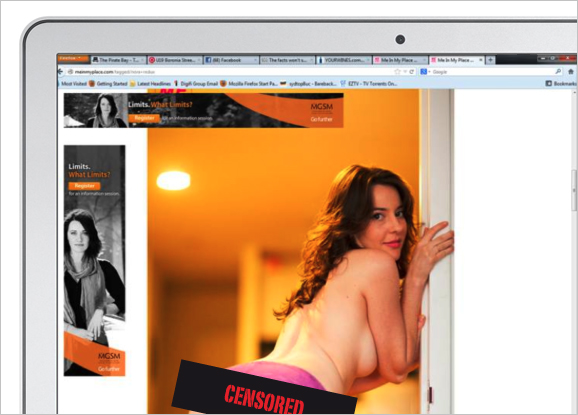
Every medium is out to convince you that their category is the best way to spend your money. They will always have a pie chart to prove it. It’s in their interest to have you spend more of your marketing pie with them. This will increase their commission, irrespective of whether it will increase your return.
For instance, Google Adwords looks a cheap way to buy eyeballs. But if your Adwords campaigner gets into a bidding war for the most popular keywords, you’ll spend more than the same number of leads from less popular search terms. Does the supplier care?
You might think the answer is to use media specialists who charge by time. Like lawyers, they’ll make more the longer their process drags on. More meetings, less decisions, the bigger your bill.
There are now more types of specialists than ever, each fighting for a bigger share of your budget – SEO, PPC, SEM, online content, online ads, email lists, data analysts, mobile, apps, ambient, ambush, experiential, waterproof stickers on urinals…
Which mediums are actually best for your business challenge?
I recommend looking at where to spend a clients’ money from this perspective:
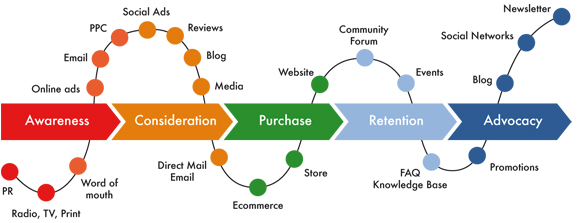
Synergy comes from the right mix, at the right time, with the right creative message. Beware commission driven specialists selling one solution to solve every problem. You’ll get less than you pay for.
Glenn Mabbott
Creative Director & Principal
UNOmarcomms
This article first appeared in AdNews
Read MoreSurvey reveals SMEs fail to measure ROI of online ads
A Yellow Pages survey of 1,800 Australian business owners* has found 69% of small and medium enterprises don’t measure the return on their online ad spend. What’s really surprising in this era of accountability is the finding that only one in 10 base their decisions on where to advertise on the ROI delivered.
What amazes me is the disconnect between business owners increasing desire to do more with less and the missed opportunities these findings reveal.
Advertisers keep telling me they love advertising online because it’s so much cheaper than traditional media. It might be cheaper to buy an adword campaign than a press ad, but are they getting a better return from those clicks?
Do you know which half of your advertising works?
The age-old saying “I know only half my advertising works, if only I knew which half” is just as true of online ad spending as off. The good news is it’s much easier to measure ROI of online marketing than the kinds of activities you used in the past. New technology makes it possible to know what works online and why. Business Intelligence means your spending can truly become an investment with predictable returns.
So if you count yourself amongst the majority of SMEs that don’t have a digital business strategy, maybe you should make it a priority to develop one. After all, there aren’t many things you can do so quickly and effectively that will leave the majority of your competitors behind.
How to measure your marketing ROI
New technologies have also made it much easier to track the performance of your offline advertising and promotion activities. We recently completed another test market campaign for an FMCG customer. In the past it was only major brands that could afford to put in place the kinds of tools needed to measure the ROI of integrated campaigns. Today even challenger brands can track the performance of programs that largely use traditional media because online research, scan data, real time field force reporting and analytics tools are no longer cost prohibitive.
The test and learn approach we have taken with this brand over the last few years has helped lift them above the pack. From being one of half a dozen small players competing for share against a long established multinational, our client is now a clear number 2 in their category. Do you know how much of your marcomms budget is working? There are no excuses because now you can.
* Survey published December 2010


"There are known knowns; there are things we know we know.
We also know there are known unknowns; that is to say, we know there are some things we do not know.
But there are also unknown unknowns – the ones we don’t know we don’t know."
While you may not like his politics, this famous quote from Donald Rumsfeld preceding the US invasion of Iraq perfectly sums up the dilemma faced by business owners today.
People are punch drunk from 5 years of relentless financial destruction of the world’s capital markets. Meanwhile, technology, and especially the digitisation of the world, has seen the pace of change of commerce reach incomprehensible pace. Is it any wonder business managers are floundering?
Challenger brands are making the most of this time of change to gain an advantage over competitors
Many business owners still think they can wait things out until things return to “normal.” What they don't know is the new model for success demands the ability to try new things, quickly and often.
Renee Todres heads a team of digital specialists at Tipping Point that have been helping businesses transform often complex transactions with their customers into simple ones. From BT to Elle Bache, once complicated business processes are being replaced with simple, intuitive interactions that make customers feel in control. Renee makes a wonderful observation –
"to learn you need to listen to yourself less."
Tipping Points approach is to add value by finding new insights. One way to succeed today is to recognise the limitations of your known knowns. Then seek out specialists that can help you discover the unknown unknowns. Get to know the ones that can help improve your position against your competition. And have the confidence to act on those new insights knowing the biggest threat to businesses today is business as usual. The Aussie attitude that she’ll be right now almost certainly guarantees failure.
I'm not suggesting spending all your energies on research. We’ve all seen managers fall into the paralysis by over-analysis trap. Too much data can actually hinder making effective business decisions. According to IBM’s 2012 global survey of 1700 CEOs, asking customers what matters to them is now more useful than financial analysis.
"Of course we need information and insight, but what we need most is the capability to act on it."
Unit head, Government, Hong Kong
In the words of Boston Consulting, today in business “the spoils go to the nimble.” We have found our challenger brand clients are winning by trying new and interesting things, fast and often. In the past you needed big budgets and big balls to try something different. There are now technologies that allow marketers to test new strategies while limiting financial risks.
As Renee and other niche specialists have shown me, it’s surprising how much there is to know that the big brands don’t, simply because they aren't looking.
Read MoreAll those for firing the Marketing Managers? Any against?


When they leave the office for the holidays, many marketing managers won’t realise their role may be restructured out of existence in the New Year. Over the Christmas break, CEOs around the country will be re-appraising who is an expendable cost to the business, versus who is an income generator.
Who will defend so many marketing managers when the case that has been building against them throughout 2012 is so strong?
Here is my snapshot of some of the evidence CEOs may be considering as they weigh up whether to fire their marketing managers:
Evidence A
Many of the tasks that CEOs thought only marketing managers could do can now be Googled. From 99 Designs to freelancer.com any CEO can buy marketing stuff cheap. Whether it’s designing websites or mailers, SEO or adwords, printing or promotions, everything is just a keyword search away. Who cares if you don’t know which half of your advertising works now you can buy it direct at third world prices?
Evidence B
According to this year's Roy Morgan annual professions ranking, marketers have failed again to rise much above used car salesmen. What CEO wants someone with less credibility than a real estate agent on their team? Consider this evidence alongside the growth in Australia of the casual workforce and outsourcing generally.
If you must have a marketing manager, why not buy by the hour, save on fixed and overhead costs.
Evidence C
CEOs have never believed marketers anyway. Fornaise regional survey of CEOs in 2011 found 75% did not value marketing managers opinions at a board level. In July this year the number had increased to 80%.
In November a follow up survey found seven in 10 CEOs hold themselves "somewhat responsible" for marketers’ poor perceived business performance because they have given up on holding their marketing managers accountable. CEOs gave up measuring the performance of their marketing managers. If it isn’t measurable, it won’t be long before the accountants decide marketing managers are an expensive indulgence a lean 21st century business can do without.
Evidence D
Business confidence is at it’s lowest level for four years. More companies went out of business in Australia in the last quarter than any other.
"She’ll be right" is now more wrong than ever. CEOs will have to change the way their business operates to survive. If they don’t know what marketing managers do, it’s an easy place for them to start cutting. As AdNews reported, one recruiter said recently, “companies want to hire revenue generators, and see marketers as passengers not drivers.“
Evidence E
How many CEOs actually know what marketing is? Consider one of the 4 Ps of marketing, price. In the FMCG industry, paying a rebate to Woolworths for a price promotion is still considered a marketing investment, not the sales tool it is.
Evidence F
Consider the other 3 Ps as they apply to businesses today. When do CEOs involve marketing managers in product development, or distribution innovation, or the building of a Business Intelligence driven CRM program? These new silos now fall under Strategy and Innovation Manager or the Supply Chain and Technology Integration Manager or the Chief Information Officer.
Is there a case for marketing managers?
The evidence doesn’t look good if the CEO doesn’t realise marketing managers can add value by thinking across silos. enabling the parts to work in synergy.
The Fornaise study found CEOs “think marketers have continuously failed to unquestionably and consistently prove in the boardroom that their marketing strategies, activities and campaigns generated actual business growth.”
To grow today you have to become a successful challenger brand. To be relevant today marketers have to champion at the board level the power of marketing to create a challenger brand.
If marketers aren’t in the boardroom, either the accountants, the salesmen, even the IT department will contend they need more of the budget to grow the business. Why not take it from the marketing pot, it’s just an artsy fartsy waste of money after all? Isn’t it?
12 days of vintage Christmas ads

Have you heard about the uproar surrounding the latest 'sexist' Christmas ad for ASDA in the UK? Here's your chance in case you missed it.
It seems that history is repeating? Here's a fun look at UNO's 12 days of vintage Christmas ads. They certainly gave us a few laughs!
On the 1st day: What more could a girl ask for?!

On the 2nd day: Should you be tempted to over indulge...

On the 3rd day: What could it be?

On the 4th day: It's the thought that counts!

On the 5th day: The perfect stocking filler!

On the 6th day: Foam filled fun for all the family!

On the 7th day: Taking care of Christmas!

On the 8th day: A shame they didn't make them for dogs too?

On the 9th day: Say it with... spoons?
On the 10th day: We all know that Santa wears red and white because...
On the 11th day: We're sure ASDA would approve!

On the 12th day: Relax in the comfort of your own home
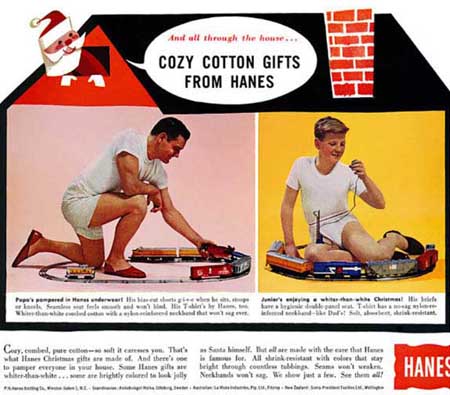
Oh what the heck! One more!
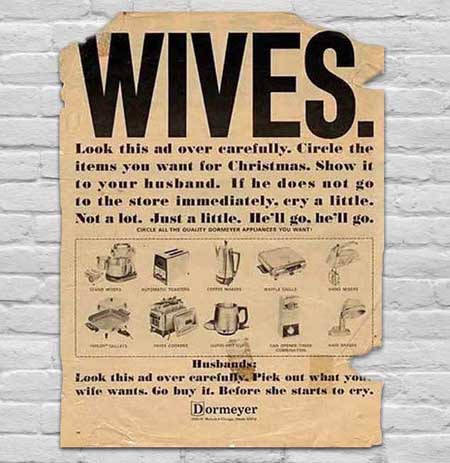
Big businesses' loss can be your gain


In the last few weeks business owners have been warned by the head of one of Australia’s biggest mining corporations that if we don’t change our business models we will die.
So who do business owners turn to for advice? In AdNews the marketing head of one of the big 4 banks reveals agencies don’t get digital. And the CEO of one of the biggest media planners in the country said "anyone in the media industry who claims they know what is happening is lying."
How many consultants does it take to change a light bulb?
Too late, fibre optics and LEDs have changed the market.
Every manager who has grown a business understands the value of seeking advice from specialists, you can’t be an expert at everything. Today we have the added problem that most so-called experts learnt their skills pre-Internet. Most business coaches are dinosaurs, as the world of commerce changes at ever increasing pace, conventional methods won’t save your business if the customer has evolved to a new way of life.
Think biz is tough? It’s even tougher for big businesses
Don’t panic. Unless you are number 1 in your category, you have less to lose by changing the way you play to fit in with the new rules that are being written by the customer. If you are a mid sized business today you have an advantage that in the past was a handicap. Yes, smaller is more nimble. Big businesses with big investments in infrastructure, systems and sunk costs can’t easily re-invent themselves. Think of all those silos of managers in big companies who have to hang in there for another 5 years because their super was decimated. They are a dead weight that slows down change.
Companies falling out of the top 3 in a given year:

Market share leaders that are the profitability leaders:

Forget the past, where’s the future profit coming from?
Most likely from something you are good at now, but not focused on. If you are a mid market player and still in business, you obviously have enough retained knowledge to draw on. Here are some examples of where UNO's clients have found profit opportunities:
- For a manufacturer it was cutting out the wholesalers.
- For a premium winemaker it is leaving Coles and Woollies to the major brands and growing high margin club membership.
- For a financial services B2B supplier it is repackaging bite-sized insights for the consumer market.
Today more than ever, get to know those who know
What you most need now is a trusted advisor who can draw upon a network of today’s specialists. To grow today, you need to re-invent your model, refresh your offer and relaunch by integrating traditional and new ways to market.
Forget incremental improvements. A few percent saved on input costs and a couple more from efficiency gains won’t save you when the competition pockets a whopping 30%+ of margin by removing an entire step in the route to market.
There’s an idea. Better to do it now, or be done over?
For a better career, get a life as a sponge


Many people in marketing seem to think they are judged on what they will do this week, while many managers think it’s about avoiding mistakes by doing very little. Rather than worry about what others may think of your actions/inactions in the short term, a recent conversation with a self-made squillionare reminded me of what it takes to become successful in business life. It’s not about you – soak up other people’s experiences.
Curiosity is the key
This founder of many businesses was as keen to ask questions about my challenges, as I was to learn about his successes.
Creative people continue to take the passive role of waiting for a brief, hoping the application of their current skills to their next project will bring the recognition they deserve. Meanwhile marketing managers act like thought police, determined to minimise all risks on their watch. So the brief ends up something like this: do something safe, measurable (as in lets make sure there are no nasty surprises), something a bit like someone else has already done, and all for less than it cost last time. This lack of desire to explore the unknown is killing creativity in Australia. Yet it’s creativity that builds wealth. Avoiding risk guarantees smaller returns, or none at all. Cutting margins does not create wealth, it just means you’ll spend your way to mediocrity a bit slower.
Today for a business to thrive it has to be a challenger brand. That’s an old company doing things in a different way, or a new one doing new and interesting things. Being a challenger is not about fine-tuning or polishing what you’ve always done. A business that’s in a well-worn smooth groove, just like a career, soon discovers it’s actually in a rut, going the wrong way. New isn’t always better, but better is always new.
If you’re curious to know what it takes to be better at what you do, you’ll do better than your peers. Curiousity, the squillionare says in one of his many books, is what it takes to succeed. It’s more than just appreciating that you don’t know everything. It’s wanting to know what Donald Rumsfeld memorably described as “the unknown unknowns.” Rather than selectively listening to those around you that you feel comfortable with, avoid making bad decisions by seeking out the wisdom beyond your network.
If you’re an art director, it’s time you hung around with some media gurus, marketing managers with entrepreneurs, accountants with digital user experience designers. Innovation after all comes from outside an industry, it’s not found fiddling around with what your category already does. And today if you don’t innovate you and the business will die.
I’ve often explained my life as that of a sponge. From childhood I wanted to know everything about everything. As I’ve met people with passions for things I know nothing about I’ve soaked up drops of wisdom. You’d be surprised what lateral connections from my sodden sponge can draw just the right drop, at the right time, to create an innovative answer. Whatever your role or experience, take every opportunity to learn from others. It helps to be open about your ignorance in front of experts. I’m always asking the silly questions. I usually find if they really are experts, they will gladly share their wisdom. Soak it up.
What's more important to CEOs - financial analysis, or customer insight?


We now work in a world awash with data. But too much data can actually hinder making effective business decisions. According to IBM’s 2012 global survey of 1700 CEOs, asking customers what matters to them is now more useful than financial analysis.
"This is now a continuous feedback kind of world, and we need the organizational nimbleness to respond."
CEO, Financial Markets, USA
"Of course we need information and insight, but what we need most is the capability to act on it."
Unit head, Government, Hong Kong
So how can you get to know your customers better? While there is no substitute for face-to-face, the survey found CEOs of outperforming businesses believe social media is the next best way to gather insights. More importantly, these insights are helping them take action.
In the words of Boston Consulting, today in business "the spoils go to the nimble."


Over 70% of FMCG categories are predetermined before shoppers enter the store. Most of the items bought in supermarkets are already determined by routine before the shopper walks down the aisle. Yet there's a massive opportunity for 28% of the product purchases where impulse purchasing still reigns. The question is, what categories do shoppers engage with instore?
The Nielsen Category Shopping Fundamentals survey shows more people go to the supermarket to buy milk (57%) than any other item. Now you know why Coles launched its massive $1 a litre own brand milk campaign to grab share from Woolworths. Yet milk is one of the least considered decisions shoppers make at point of sale. Over 70% of shoppers aren't engaged by the category in the store.
It's a similar story for pet food and toilet paper. If you're a marketer of these low engagement instore categories you will get a better marketing ROI from a brand advertising campaign or an incentive before people go shopping.
Low engagement products don't benefit well from instore merchandising
Prospects who are less interested in your product instore are best marketed to out of store. From flyers to shopper dockets, catalogues to mobile promotions driving people to the store you will have better impact than attempting to get their attention while on autopilot in your category aisle. Packaging and instore merchadising is also less likely to switch customers between brands than other categories where people are actually paying attention.
However over half the shoppers surveyed are engaged by the process of shopping, just not with every category. So it follows knowing which category a product falls into helps marketers decide where to best invest in marketing.
The high engagement FMCG categories are frozen snacks and desserts
Shoppers are more engaged by more indulgent purchases like frozen desserts (64%) and infrequent purchases like toothbrushes (64%). Here is a snapshot of what shoppers are looking at with their brains switched off versus on:
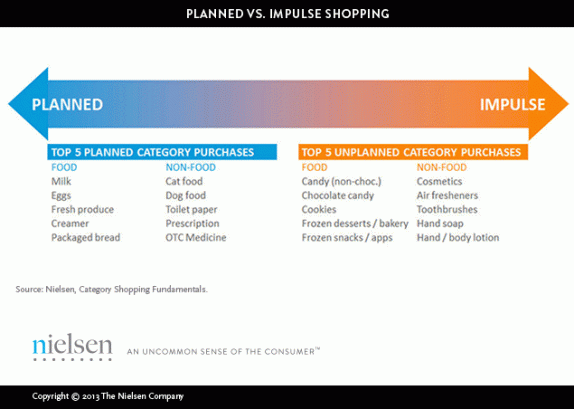
Categories with high engagement are better served by product innovation, instore merchandising and promotions and eye catching packaging.
Our marketing for Pacific West frozen seafood and snacks was centred on creating news and a fresh take on seafood. More adventurous choices has proven to be a more appealing strategy to the predictable product and positioning of Birdseye and I&J. Seven years of year on year growth for Pacific West shows what a difference it makes when you leverage an engaged instore audience.
Read MorePugs & Kisses & Christmas Wishes

(Click to Play)
A sincere thanks to our friends and colleagues for sharing our journey in 2013, UNO’s 13th year growing challenger brands.
We wish you and your family (and all creatures great and small) all the best for 2014.
Once again rather than send cards, we are supporting four koalas through the caring efforts of The Koala Foundation.
Best wishes from the UNO family.
Read MoreAIDS ads that changed our lives: If it's not on, it's not on

Australia faced a big problem in the 80s: AIDS was killing us
In the late 1980s AIDS was spreading unchecked in Australia amongst sexually active adults with multiple partners, homosexual males and intravenous drug users. Most people had no idea how you could catch it and there was no known cure. The only certainty was if you found you had AIDS, it was a death sentence.

The first government advertising campaign to raise awareness of the issue had failed to address the spread of AIDS. While “The Grim Reaper” ads certainly gained attention, the messages had not connected with those at risk and had not changed unsafe sex practices.
Indeed the Grim Reaper had simply scared the general public, especially kids and older people, without offering a compelling safe sex message. In charge of the government's AIDS awareness task force, Ita Buttrose had acknowledged the mistake the Grim Reaper fear campaign had been. The agency responsible that she'd appointed was fired and we were asked to implement our campaign they'd originally passed over for the Reaper.
The creative solution: "next time you go to bed with someone, ask yourself..."
"...how many people are you really going to bed with?"
You can't scare people into doing what's good for them. In fact, it's human nature to reject being told what to do. The art of persuasion often begins with starting a conversation that acknowledges the audience's point of view. And builds from there with an undeniable logic.
This commercial for the first time educated the community it wasn't "other people" who got AIDS, it was potentially anyone who went to bed with someone for unprotected sex.
Shot by Ray Lawrence (who went on to direct Bliss, Lantana and Jindabyne) my AIDS "beds" ad was made before the era of computer generated images. We put 800 real people into 400 real beds in the largest space we could hire in Sydney, the old tobacco bond store in Moore Park. The campaign worked in achieving the brief of raising awareness and driving behaviour change amongst those most at risk. The managers at Ansell would report an uplift in condom sales with every burst of our ads.
It's not often in this business you get the opportunity to really make a difference for society. It's usually baked beans and banking products.
Over three years as lead creative communicator I helped develop a series of undeniable messages that were created for specific audiences. From mass market messages on TV and radio, brochures for distribution in health clinics, English as a second language ads in ethnic press to bus sides and gay street press, posters on beats and stickers on public toilet doors.
The “Beds” ad which asked “next time you go to bed with someone, ask yourself how many are you really having sex with?” gave a graphic explanation of the chain of infection. The “Tell him if it’s not on, it’s not on” ads empowered people to demand their partners wear a condom. On the back of dunny doors in pubs across the country you couldn't ignore the big sticker of a condom clad erect penis with the words: "cover yourself against AIDS"
The outcome: Australia led the world in stopping the spread of AIDS
The integrated advertising campaign successfully raised awareness of AIDS amongst those segments of society most at risk of infection. The messages also reassured those not at risk and transformed the public view from one of “victims of AIDS” to an empowering safe sex message.
The creative campaign was instrumental in educating the public and changing sexual behaviour to succesfully reduce the transmission of the AIDS virus. The leader of Australia's health sector tasked with stemming the epidemic acknowledged the strength of the campaign:
“The message in this war against AIDS is a tough one – we know it will be controversial but we are certain it is the right approach, and it is backed by the World Health Organisation.”
Professor Ron Penny, National AIDS Council, 1988
This AIDS campaign is still recognised around the world as the most effective of it’s kind
Read MoreObstacles to innovation: A jeweller’s tale


Have you read the retail sector is finally looking up? Unfortunately not for everyone.
A friend of mine is one of Australia’s leading luxury jewellers. This year his turnover is down 20% and the word in the trade is over two dozen high-end jewellers around Sydney are on the brink of closure. That’s a lot in such a niche category. What has served them well for decades has seemingly evaporated overnight.
Where have the sales gone? A few years ago no-one had heard of Pandora as a brand of jewellery. Australia is now Pandora's fouth biggest market in the world. Or have you heard of The Iconic as a place to shop for fashion? Last week The Iconic turned over $1,000,000 of online sales in one day.
The simple answer for retail is to go online, right?
My jeweller’s quandary is he opened an online store with a similar offer to his shop and failed to gain any incremental growth.
Global changes demand an innovative response
It’s not just small high-end jewellers suffering from change. The global super premium brands are suffering the curse of ubiquity, Louis Vuitton sales are plummeting despite the increase in purchases of luxury goods by the emerging Chinese millionaire class.
We are increasingly seeing fashion conscious style setters seeking designs from unknown startups, boutique designers that they can tell friends they’ve discovered. Being in the know has more credibility with peers than wearing what any person with a Platinum card can buy in any Gucci store, from Guangzou to Fifth Avenue, Sydney to Roppongi.
Big brands have difficulty innovating as they have an aversion to cannibalising their existing business. It becomes harder the bigger and more established you are, which fortunately gives Australian challenger brands an advantage. The barriers to innovation have been identified in a Australia wide research by the Australian Institute of Management:
What’s stopping Australian businesses innovating

My friend said he had come across an offshore maker of silver jewellery, gold plated with semi-precious stones that look amazing but only retail for $300 to $500. His fear is if he stocked them no-one would continue to pay $3,000 to $5,000 for his similar looking existing product.
My suggestion to my jeweller friend is to take advantage of his ability to be more nimble than a Tiffany. He isn't facing the number one barrier to innovation, a lengthy development time and there is a way he can try something new with minimal risk. If he quickly sets up a small online store under a different brand, he then has no reputation to lose and can test the appetite for this new product.
The ability to test the mix of product and price is easily done with an online store. I’ve written in the past about how we can learn from fashion retailers that are innovating for pricing advantage.
The study shows the upside to trying new ways by becoming an innovator in your category is huge.
Innovation leaders Vs laggers: business performance ratings.
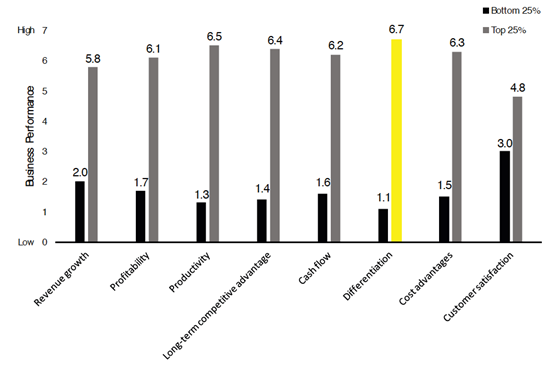
Innovation leaders are two to three times more successful than innovation laggers in terms of growth, profitability, productivity and cash flow. Risk obviously has greater rewards than business as usual. One UNO case study proves the point, Butterfly Silver was the first Australian Jeweller to apply a fashion forward procurement model to become a successful challenger brand.
Source: University of Melbourne and the Australian Institute of Management. 2013
Read MoreSales conversion rates: the facts

Sales call stats – how does your team rate?
48% of sales people NEVER follow up with a prospect.
25% of sales people make a second contact and stop.
12% of sales people only make three contacts and stop.
Only 10% of sales people make more than three contacts with a prospect
So if your sales people are typical of all sales forces, what are the consequences of only 10% of them calling on a prospect more than three times?
Conversion rates increase with sales call rates
2% of sales are made on the first contact.
3% of sales are made on the second contact.
5% of sales are made on the third contact.
10% of sales are made on the fourth contact.
80% of sales are made on the fifth to twelfth contact
Sure, it costs more for your people to call more than 3 times, but consider your return on investment when you factor in the typical conversion rates. Three calls and under only converts 10% of sales!
If your sales people are not following up, the stats indicate there is little to be gained by simply adding new names for them to visit. It also shows the value of building brand awareness before the sales person calls.
Source: Richter10. Thanks to Rick Allen for sharing
Why are most ads so bad nowadays?


Bartle Bogle Hegarty was the London ad agency every ambitious Australian creative wanted to work at in the 80s. They made a series of great ads for Levis including “laundrette”, came up with "Vorsprung durch Technik" for Audi, "The Lynx Effect" for Unilever and "Keep Walking" for Johnnie Walker whiskey.
BBH creative founder “Sir” John Heggarty will speak at a global advertiser conference in Sydney in March. He has already given an idea of what advice he has to for Australia's advertisers.
What is the state of advertising creativity today?
“It’s one of the best times ever to be in advertising but why is it the work is poor,” he told AdNews from his organic and biodynamic vineyard in France. “I don’t know of any other industry in the world that would say the way to succeed is to make a worse product. And we seem to be in that situation in advertising."
CEOs in Australia say they want creativity
More than anything else, a recent Australia wide survey of CEOs shows they want their marketing agencies to be creative. Yet one look around shows how poor ads are today.
The CEO of a financial services group asked me recently what killed the Australian ad industry? "The Internet?" he asked. "Globalisation" I answered.
The fact is, in Australia the biggest brands mostly run ads from somewhere else. They don’t care if their ads don’t work very well here, in the global scheme of things one year’s revenue in Australia can be surpassed in one long-weekend in Florida.
So I wasn’t surprised to see Sir John identify the cause of mediocre advertising. “You can talk about technology being the reason but for me the biggest issue is the globalisation of our industry. We don’t seem to be able to create work globally that has impact. I think marketers today are losing contact with people despite the fact they have many more ways of communicating with them.”
Meanwhile home grown ad standards are going down, down
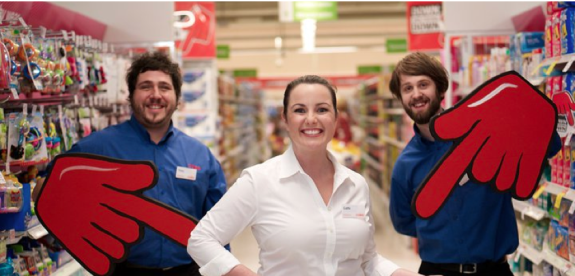
We are increasingly bomdarded with ads produced in-house by Australia's retailers, further driving standards down, down. Over 30 years creating ads has taught me great creativity sells. Especially when developed by local writers and art directors who are in touch with the essence of what makes Australians tick. I believe clients are best served by ads that tap into human insights, no matter how small. When told with humour or compelling gravitas a human truth will cut through where so called big ideas with big budgets and big name stars fail to connect with real customers.
Are you more inclined to buy from someone you like? I know I respond better to brands that have an endearing conversation with me, rather than a list of claims shouted at me, even when put to a jingle. The answer to appealing to customers doesn't lie in more data.
Sir John also warned about the dangers of data and analytics –
“Clients are desperate for salesmanship to be a science. They would love it to be. They would love to be able to say this equals that and this will be the return on investment so let’s do it. But they can’t. In the end it’s a judgment call you still have to make.”
Lets all hope more advertisers re-embrace the power of creative story telling, it makes better viewing.
Read MoreCustomer loyalty in Australia comes at a different price to O.S.

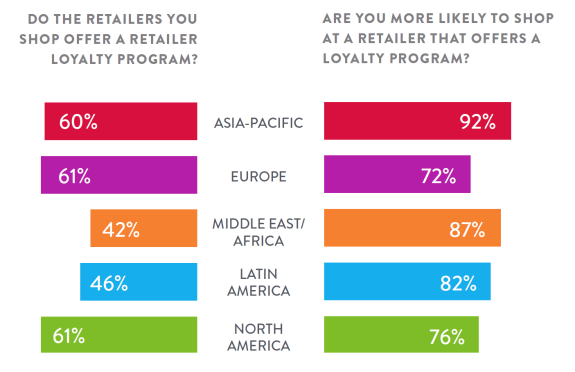
Our region ranks 1st in responsiveness to loyalty programs
We now have proof customers in the Asia-Pacific are the most willing in the world to reward businesses with loyalty. Whether you are in a service or product category, the good news for Australian business managers is your customers' loyalty doesn’t have to come at the price of discounting.
Don’t think global when marketing local
You can out-maneuver big brands that continue applying globally what works in their home market. Consider implementing strategies that Australian customers will reward with loyalty.
The US is introspective, remember it's the country that has a World Series with only US teams. Most US companies don’t have our local market's needs on their radar. Meanwhile, Europe’s big brands are struggling at home with a deflationary market. These parochial management mindsets offer Australian brands an unique opportunity. It's the perfect time to think and act local where big global players have a tendency to universally apply one strategy.
A global survey now shows us just how different Australian consumers are compared to the home town customers of global brands.
The Neilsen Global Report of Loyalty shows our customers are different
Unlike Europe and the US where 82% customers want discounts and free products as a reward, in our region we are less motivated (70%) than anywhere else by something for nothing. Here customers lead the world in valuing good customer service (53%) and exclusive deals (41%). The Customer Loyalty Report shows your customers want you to give them quality and service more than just price:
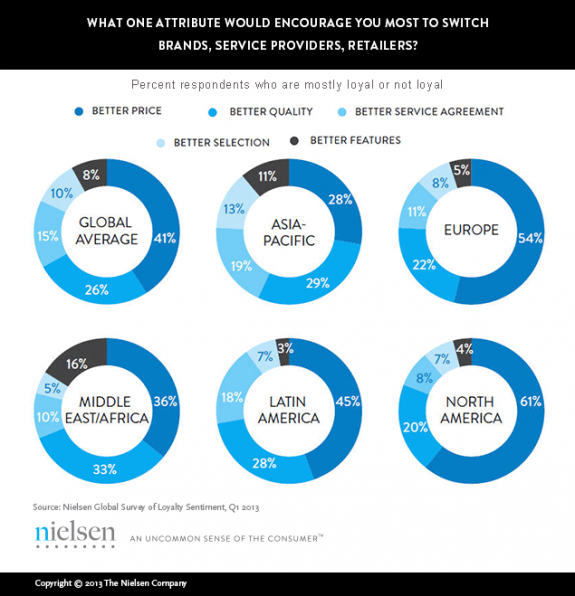
Loyalty programs can improve profits
UNO applied the disciplines of building a loyalty program around quality and service for Vivien's Jewellers. We replaced monthly cardboard in-window price promotions with quality themed creative store merchandising. We introduced a VIP loyalty program that emphasised exclusive product offers. Sales, discounting and price promotions were no longer frequent, being replaced with special occassion sales through invitation-only Wednesday night store openings. While Angus & Coote and Michael Hill were seen to be always on sale, we built a reputation for accessable aspiration.

Over 5 years we transformed Vivien's sales base from only 25% repeat sales to 75%. This also helped Vivien's double the number of profitable stores and ultimately sell the business at a category premium.
I continue to encourage our challenger brand clients to compete with the global competition by developing marketing strategies focused on what customers really value. The big guys often lack the ability to get close to the customer, let alone respond. You may have noticed over the last year a number of visiting global FMCG heads lamenting how hard it is for them to make money in the Australian market. Coles and Woolies forcing them to cut margins isn't helping.
Do you cut for share or innovate to grow?
Increasingly businesses nimble enough to canibalise their existing sales by trialing new products or services will gain market share in the long term. And because they aren’t discounting, those sales can be more profitable.
Spend your time looking at ways to make your customers feel understood and then invest in a creative communucation of your differentiated proposition. Let the global brands discount their way to local irrelevance.
Read MoreFrom the people who gave us wooden pillows – brand differentiation

Do you think it’s hard to differentiate in your category?
 A trip to Japan gave me a fresh perspective on how to make any brand stand apart from the competition.
A trip to Japan gave me a fresh perspective on how to make any brand stand apart from the competition.
Last month I bought a new mattress from David Jones Sydney city store. Each brand had the same proposition: sleep soundly and wake refreshed. Choose between hard or soft, affordable or expensive.
Talk about a lack of fresh ideas, the promise of a good nights sleep hasn’t changed since I worked on the Simons mattress account 30 years ago, or the idea of looking after your back when I marketed Sealy “Posturepedic” 20 years ago.
The Japanese have a strange way of looking at brand propositions
At least on first view this first world nation has some peculiar ideas about brand messaging. The English language isn’t used by 999 out of 1,000. And Japan has a proud history of maintaining thousand year old traditions. So this different background means common products are often promoted in totally different ways to our western approach.
A couple of weeks ago I checked out the merchandising of mattresses in a central Tokyo department store. Here are some pictures I took when the salesman wasn’t looking – mattresses marketed the way Nike sells shoes.
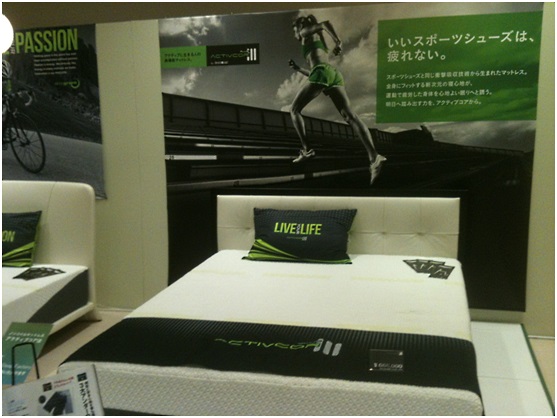

Nothing soft and fluffy about this positioning – “Activor, the next generation in sleep technology.” Hi-tech performance for the modern Japanese consumer.
Feeling inspired? Whatever your category, you can find inspiration from taking a completely different perspective.
P.S. Aussie mattress brand repositions for export market
Local mattress maker A H Beard has just launched in China. Unencumbered by any legacy in this new market, how are they differentiating? Their first mattress for Chinese consumers retails for over $20,000. That should set them apart.
Read MoreVale Scott Kennedy – one of NZ's finest artists
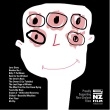
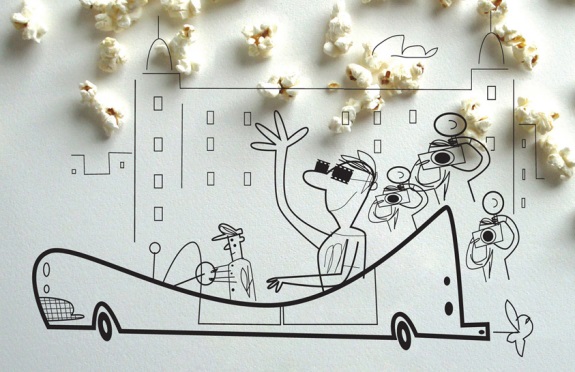
Our professional careers are sometimes touched by the most inspiring personal relationships. I was blessed with the early entry into my life as an Art Director by an artistic genius from across the ditch, Scott Kennedy. It was the early 80s and any Kiwi artist of promise had washed up in Sydney seeking a broader canvas.
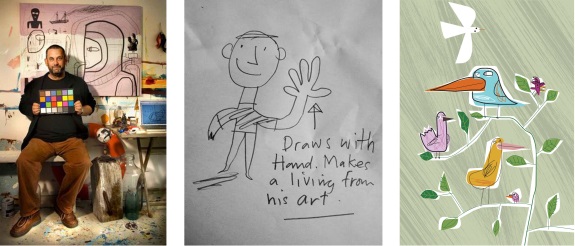
Scott bid us goodbye last week after a painful but defiantly good-humoured fight with cancer. At the end his hands wouldn’t work, but Scott’s creativity was always alive in his one of a kind headspace.

As you can see Scott’s view of life was re-expressed through the lens of 60s cartoon characters and tin toy robots and Dr Strangelove. His ex-US Army dad had relocated the entire family from California to New Zealand in the belief it was the safest place to be when they dropped The Bomb.

I loved Scott for his quirky humour, big heartedness and child like enthusiasm for new creative possibilities. Have a Captain Cook at Scott’s book covers for the popular How to… series, no surprises which is my favourite.
I write this while wearing Scott's "Joy kills sorrow" T-shirt, which is a fitting memorial to his precious time with us.
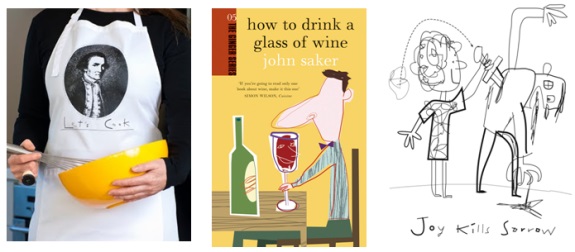
What CEOs want from an agency
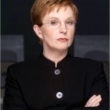

The top 3 things CEOs and CMOs want from their agency according to a survey by the Communications Council are:
1. Innovation and creativity
2. Leadership
3. Integrity
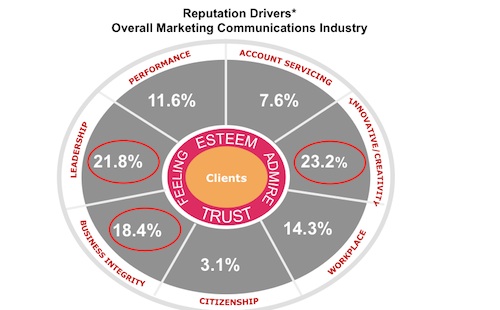
Funnily enough, the leaders of agencies put Leadership last.
Which could explain why three quarters of CEOs don't value marketers at the board level.
I wonder if this is a reflection of the transaction based relationships most agencies seem to be stuck in today. Whatever happened to “fearless advice”. It's what most left brain business managers want from right brain agency creative thinkers. Creative thought leadership is where agencies add value, not servile account management.
Perhaps it’s a consequence of a co-dependent relationship between ignorant brand managers and subservient suppliers. Meanwhile the smart business leaders appreciate the real value to be added is at the board level, with lateral and entrepreneurial advisors from outside their organisation helping them challenge traditional business models.
Read More







Scan the QR code for our contact details.
Download the Neoreader app.
© COPYRIGHT 2013 UNO marcomms Privacy